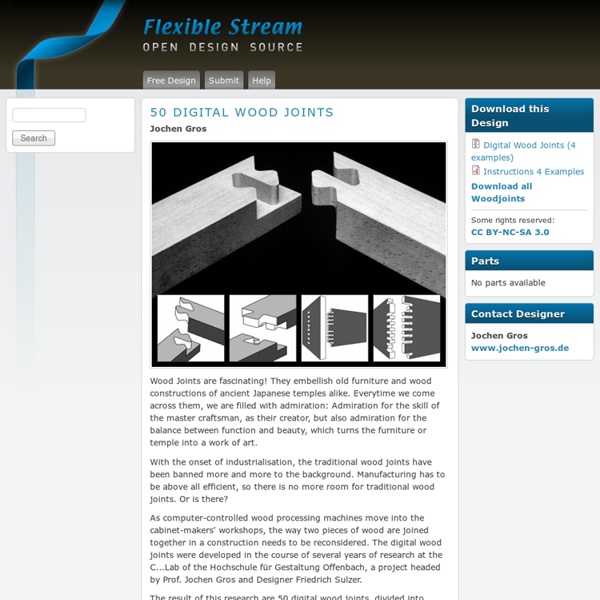Global Village Construction Set by Marcin Jakubowski
Open Source Ecology is a network of farmers, engineers, and supporters building the Global Village Construction Set - a modular, DIY, low-cost, open source, high-performance platform that allows for the easy fabrication of the 50 different industrial machines that it takes to build a small, sustainable civilization with modern comforts. The aim of the GVCS is to lower the barriers to entry into farming, building, and manufacturing. Its a life-size lego set that can create entire economies, whether in rural Missouri, where the project was founded, or in the developing world. So Far we’ve prototyped 8 of the 50 Machines and we’ve been expanding rapidly. We are 100% crowd-funded. We have 400 True Fans that support our work monthly. Please watch these videos if you are new to the project: What Makes the Global Village Construction Set so special? Why should I help fund this project? The library of instructional material that we produce will make replication a straightforward task. Absolutely!
How-To: Mix and Mold GFRC
Concrete, as most folks know, is strong under compression but weak under tension, and is commonly strengthened by casting it around, e.g. a grid of steel reinforcing bar (“re-bar”). Glass Fiber Reinforced Concrete is, well, pretty much exactly what it sounds like: concrete reinforced with glass fibers. As in most composite materials, the fiber elements in GFRC can be carefully oriented, or randomly distributed, in the solid matrix. The nice thing about the latter method is that you can just mix the reinforcing fibers into the bulk concrete and don’t have to pre-position them in the mold. If you’re interested in experimenting with GFRC, however, you may have noticed that practical how-to information is a bit scarce online. In the first, Brandon details three different concrete mix recipes used in the casting of a GFRC bathroom counter with integral sink. Concrete Decor – GFRC Mix DesignConcrete Decor – GFRC Application Related
CNC Panel Joinery Notebook
I’ve been collecting clever ways of slotting flat stock together since I first read Nomadic Furniture back in 1999, well before the advent of the accessible hobby-class CNC tools that, today, make manufacturing parts like these pretty easy. Now, the world is full of people designing models, project enclosures, sculpture, furniture, and all kinds of other cool stuff to be assembled from parts made on laser cutters and CNC routers, and I keep expecting a definitive book or website to emerge that covers the “bag of tricks” in an organized way. So far, I haven’t found it. I may have missed it. Or maybe this article can serve as a jumping-off point. In presenting this material, I want to first acknowledge my respect for the world’s established and ancient traditions of joinery. I may abuse some terms, without meaning to, and I am glad to be corrected by those who are in the know about traditional joinery. To simplify things, at first, I’m only considering joints between two panels. Biasing
Facit Homes
ICT Graphics Lab
The Graphics Lab at the University of Southern California has designed an easily reproducible, low-cost 3D display system with a form factor that offers a number of advantages for displaying 3D objects in 3D. The display is: autostereoscopic - requires no special viewing glasses omnidirectional - generates simultaneous views accomodating large numbers of viewers interactive - can update content at 200Hz The system works by projecting high-speed video onto a rapidly spinning mirror. As the mirror turns, it reflects a different and accurate image to each potential viewer. While flat electronic displays represent a majority of user experiences, it is important to realize that flat surfaces represent only a small portion of our physical world. We describe a set of rendering techniques for an autostereoscopic light field display able to present interactive 3D graphics to multiple simultaneous viewers 360 degrees around the display.
10 Air Purifying Plants For Homes & Offices
Even in huge, busy cities, outdoor air is cleaner and preferable to indoor air. Why is that? One reason is that trees and plants are constantly cleaning the air outside. The Areca Palm (Images via Plant Directions, EnvicoGarden) NASA Purifying Score: 8.5 The top air purifying plant as ranked by NASA’s study is the Areca palm tree. The Lady Palm (Images via Livick’s Palms, TyTy) Neck and neck with the Areca palm tree for NASA’s top-ranked air purifying plant is the Lady palm (or Rhapis excelsa.) The Bamboo Palm (Images via Blue Moon Candles, Plant Importers) NASA Purifying Score: 8.4 Just a notch below the top 2 air purifying palms is the Bamboo palm (or Chamaedorea seifrizii.) The Rubber Plant (Image via HowStuffWorks, Great House Plants) NASA Purifying Score: 8.0 Fourth on NASA’s scoring is the rubber plant (or Ficus robusta.) The Dracaena (Images via Natural Surrounding, House Of Plants) NASA Purifying Score: 7.8 English Ivy (Images via Overstock, OSU) NASA Purifying Score: 7.8 The Dwarf Date Palm
Hexayurt Project - incredibly cheap shelter for those in need
Pamper Your Tools | MachinistBlog.com
By John Hill on July 25, 2011 Start with one of these …and one of these… …some of your treasured tools and instruments.. …covered with a bit of cloth from the t-shirt.. …shake up a can of this… …lay it on them.. …lay some newspaper over it… …pat it down and squish it around to fill any voids… …get a good night’s sleep and in the morning..



